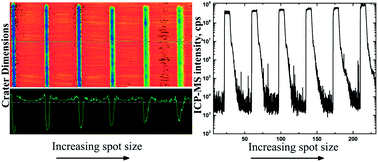Ultrafast laser ablation ICP-MS: role of spot size, laser fluence, and repetition rate in signal intensity and elemental fractionation
Abstract
Ultrafast laser ablation inductively coupled plasma mass spectrometry (LA-ICP-MS) has gained prominence in recent times owing to its superior capabilities in eliminating fractionation effects providing the possibility of developing a non-matrix matched calibration system. Though ultrafast laser ablation sample introduction provides better accuracy and precision compared to long-pulse nanosecond lasers, the fundamental ablation mechanisms using femtosecond lasers are still not clearly understood. In this study, the role of spot size, fluence and repetition rate has been studied using brass and NIST 612 samples to understand their signal intensity and fractionation effects. A white light interferometric microscope has been used for crater analysis and the results are correlated with the LA-ICP-MS signal intensity and measured elemental ratios. The results show that the spot size, laser fluence and repetition rate can play an important role in overall performance of the LA-ICP-MS system as well as in elemental fractionation. Crater measurements also show that the ablation mechanisms are different for the NIST 612 sample and brass and the observed differences are discussed using ultrafast ablation theories.

- This article is part of the themed collection: 2014 Young Analytical Scientists

 Please wait while we load your content...
Please wait while we load your content...